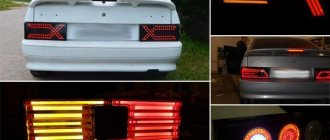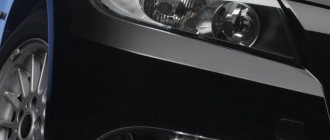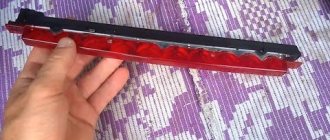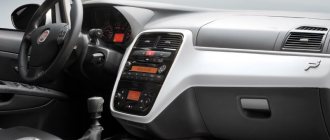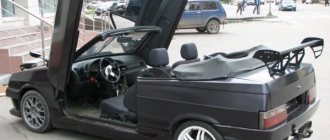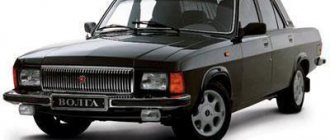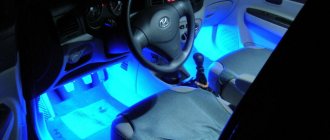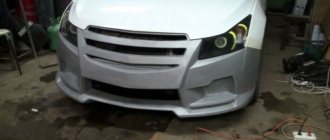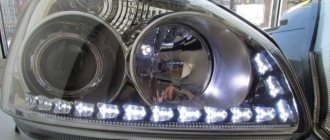Legality of homemade brake lights
The rules regarding car tail lights do not contain any detailed data on the spectrum of light color, focus, etc., there are only geometric rules for the distribution of light on the car, generally defined colors and a precisely defined range of visibility.
In the end, commercial LED lamps are often too overloaded, they have too small limiting resistors, because the manufacturer thinks that when he puts 3 or 4 diodes in a row, it is already almost 12V and puts a tiny resistor accordingly. Consequently, the likelihood of problems with headlight failure increases.
DIY LED tail lights for cars
It started with the purchase of an old Ford. The car, although almost completely restored by the previous owner, had many minor problems (mostly electrical in nature) as well as functional defects resulting from the old design. It was decided to refine it a little by introducing more modern elements, for example, the front lamps - the original incandescent lamps - were replaced with ready-made H4 LEDs.
But the taillights created difficulties. Initially, each contained only one ordinary 5/21 W double-helix light bulb. The reflectors were made from ordinary galvanized sheet metal. The previous owner used chocolate foil, but the effect was - although somewhat better - still weak - in the daytime the brake lights were difficult to distinguish from the parking lights.
It was decided to improve the lamps by inserting LED assemblies into the places for the original lamps. The cheapest set of matching LED headlights I found for sale was over $100 plus shipping. In general, we decided to do this thing cheaper, that is, assemble it ourselves.
Connecting LEDs to car wiring
LED headlight circuit with resistorsLED headlight circuit with stabilizers
All three headlight segments are mounted on a common board made of 1.5 mm thick fiberglass, cut to a shape that exactly matches the contour of the rear headlights. After testing several types of LEDs, Super Flux (with lens) with 80 degree beam angle, 5mm diameter and 20mA current was applied.
The diodes themselves are mounted on a universal board with current stabilization based on resistors, instead of a special driver, and this thing looks a little careless, only it is hidden between the reflector and the diffuser, so only the geometrically correct configuration of the modules is important.
The three panels are connected in parallel and powered directly from the car's 12V wiring using an adapter simulating a lamp base (made from a burnt out light bulb).
The design of the panel itself is 4 LEDs connected in series (horizontal lines), each line has its own resistor (180 Ohm / 0.25 W) limiting the current. The lines are connected in parallel - everything is powered by a rectifier diode connected to the positive wire.
Weaker parking lights are implemented by supplying power from a second rectifier diode in series with a 390 ohm/0.5 W resistor.
Everything draws current in the 0.5A range (a regular light bulb is about 2A). The diodes operate under ideal conditions - a voltage of 2.2 V and a current of 20 mA are almost nominal recommended values. Now the durability of the entire lamp will depend only on the reliability of the LEDs themselves.
The use of a limiting resistor of 300 - 470 Ohms for each LED makes its operation essentially eternal, since the permissible current will not be exceeded, even when the voltage increases abruptly to, for example, 18 V, which is already a definite malfunction of the car.
When there are several LEDs in series across this resistance, there is even more confidence in longevity.
Useful: Converting LED lamp to Li-Ion power supply
This may not be a perfect solution, but with a well-functioning auto voltage regulator and a functional battery, voltage spikes should not exceed 14.8 - 12.8 = 2 V or 0.5 V per diode.
Testing homemade LED headlights
After about 2 hours of testing, the system reached a temperature of about 35 degrees, that is, despite the use of resistors instead of chip inverters, much less than an equivalent incandescent lamp.
The uniformity of backlight shades is not ideal. The lower part of the headlights is good - the diodes shine perfectly with rows of lenses and illuminate evenly. Higher up - due to the tilt of the glass LEDs, the light begins to scatter a little, and the brightness depends slightly on the viewing angle.
It would have been possible to customize the LED strips in stages, but the priority was to provide a reasonable cost-to-effort ratio that would completely satisfy the car owner.
- After a month of testing, when the car traveled about 2 thousand kilometers, not a single LED burned out. Let's see how it goes next.
- After a year of driving, when the car traveled about 10,000 km, one diode was burned out and one strip went out. Probably turned out to be defective.
The time investment for these car tail lights is 3 days to 2-3 hours a day, and the cost of materials for both lamps is 3000 rubles - this is very good.
Legality of homemade brake lights
The rules regarding car tail lights do not contain any detailed data on the spectrum of light color, focus, etc., there are only geometric rules for the distribution of light on the car, generally defined colors and a precisely defined range of visibility.
A little more about the durability of LED car headlights - two homemade LEDs on the VAZ license plate bulb, each with its own 470 Ohm resistor, have been working for about 12 years. So these tail lights will also be almost “eternal”, of course, if you do not take into account random failures such as a short circuit on the circuit board.
In the end, commercial LED lamps are often too overloaded, they have too small limiting resistors, because the manufacturer thinks that when he puts 3 or 4 diodes in a row, it is already almost 12V and puts a tiny resistor accordingly. Consequently, the likelihood of problems with headlight failure increases.
3— 5,00
CLICK HERE AND OPEN
Source: https://2shemi.ru/svetodiodnye-zadnie-fonari-dlya-avto-svoimi-rukami/
Manufacturing of diode rings
To create taillights with your own hands, you need the same epoxylin and strong glue. The basis is diode rings or tape. The body will be made from small and large reflectors, which can be found on the hardware market. The last element is the paint, which the motorist likes best. Most VAZ 2114 owners choose chrome paint.
- Diode rings must be installed in cylinders, which are best made from tin cans.
Coffee or canned food cans are suitable for this. Processed tin can - They must be carefully cut out so that at the end something similar to a well appears. There should be two of them - internal and external. If a coffee can can serve as the basis for an external well, then the internal one can be made from an ordinary 0.5 liter plastic glass and then painted.
- Now simple Soviet cataforts should be installed in the internal wells.
They should provide illumination according to the standard scheme: turn signals - orange, reverse - white, fog lights - red. After this, extra elements may remain from the large catafort, which will look great inside the module. The rest of the space can be decorated with any LED ring. Decorated wells look impressive, but you can’t see what they were made of - The next procedure is to install the reflectors and LED rings. In order for them to hold securely, it is necessary to make stiffening ribs, as an option - epoxylin.
- You can put additional lighting on the plexiglass and secure it with epcosilin.
As a result, you should get such tuning yourself. Detailed visual aid for installing LEDs in VAZ optics:
Preparing for tuning
To make LED taillights with your own hands, you need to purchase a certain number of diodes. For standard diffusers, the best option may be white elements with a power of 12-16 volts. If you plan to install clear lenses, then you should buy red LEDs for the parking and brake lights. For turn signals you will need orange elements, and for reverse optics - white diodes.
It is recommended to buy LEDs with a reserve in case a certain number of elements fail during operation, you can immediately replace them, rather than running around looking for the right model in stores.
The number of LEDs must be selected based on the specific features of the flashlights so that there is enough space in each optics section. You should also take into account such a moment as the turn signal flashing relay. In the design of a car, each relay is selected taking into account a certain load. Therefore, it is necessary to provide the number of LEDs that will correspond to this parameter. Otherwise, the blinking frequency of the optics will differ from the standard pattern.
In addition to LEDs, you need to stock up on thin plastic made from foil getinax or dielectric. It will be needed to arrange the mounting of diodes.
If you use getinax, you will have to etch out the current-carrying paths according to the number of installed elements. Although this method is labor-intensive, however, this design will be more compact and durable. In the case of a dielectric, power is provided more easily, using a thin wire. In this case, care should be taken to securely fasten the wiring and other elements to prevent damage to them due to strong vibration.
All LEDs are sensitive to vibration and shaking, so care should be taken to securely mount them. The elements must be inserted with tension. In this case, the connection of wires with diodes must be done only by soldering.
The power connection is made in parallel through resistors, which are designed to limit the currents passing through the diodes. In order not to select resistors yourself, it is better to immediately buy them complete with LEDs.
Color film
Another budget option for tuning car optics is a color film sticker. This method does not require significant financial costs and a lot of time. You should prepare in advance:
- sharp knife and hair dryer;
- marker and rubber squeegee;
- soap solution and napkins;
- tint film of the desired shade;
- headlight installation tool.
Tuning headlights with color film
As in previous cases, it is recommended to dismantle the optics, clean, rinse and dry. Further work is performed in the following order.
- Placing the color film on the headlight and marking the contours of the workpiece.
- Cutting out the part along the marked lines.
- Degreasing the glass surface.
- Removing the protective film layer.
- Applying soap solution to the headlight.
- Gluing the workpiece and smoothing it out.
- Installation of optics in a regular place.
Tuning headlights with color film
To avoid the appearance of air bubbles and/or folds, the film should be smoothed with a rubber squeegee, which is done slowly, while simultaneously heating the surface with a hairdryer.
Step-by-step assembly instructions
To assemble a diode tail light with your own hands, you can use various instructions. Let's consider the simplest and cheapest option for making such a lighting installation with your own hands, based on the use of an LED ring. For this we will need the following materials:
Cree LED Reversing Light
- red diodes with a diameter of 5 mm (64 pieces). You can take medium brightness;
- for stops – 20 LEDs with increased brightness;
- resistance (120, 150 and 270 Ohms);
- 12 V power supply – needed for testing;
- a can of matte black paint;
- 4 pieces of plastic. They should be even;
- 4 voltage stabilizers, which will be used for dimensions.
Tools you will need:
- screwdriver;
- glue gun;
- wire cutters;
- knife;
- heat shrink;
- soldering iron;
- tester;
- technical hair dryer.
Step-by-step instructions for assembling the lantern are as follows:
- We cut off the glass from the old headlights. To do this, it must be constantly heated with a hair dryer;
- Next, we take out the light diffusers and paint the reflectors black;
Headlight without diffusers
then from a piece of plastic we form a platform for placing LEDs in it and implant the LEDs into it;
Prepared plastic platform
- We solder the leads from the standard headlight sockets to the LEDs and connect them to check that the light sources are connected correctly;
- We solder stabilizers into the electrical circuit;
Soldered circuit elements
We put a reflector painted black on top of the diodes;
we install all the components of the lamp in place;
Reinstalling the LED backlight
DIY LED headlights
- After that, glue the headlight glass back onto the sealant. The sealant takes a couple of days to harden;
- Next, we remove the bumper and under it we find the guides with which the headlight is held on it;
- carefully screw the headlight into place, having first connected all the wires.
Finished tuning result
The steps described above must be repeated for all lights that are located at the rear of the vehicle.
Do-it-yourself round taillights for a VAZ 2110
This article will be of interest to those who decided to replace the rear lights on a VAZ 2110. For those who have another car, this will be an excellent example for such a homemade product.
Today we will look at how to make round headlights, like those on legendary sports cars. Unfortunately, for the VAZ 2110 there are no such kits so that they can be installed, so here you have to do everything yourself. There are several options for how to make such headlights. The easiest way to do this is by remaking the standard VAZ lights. But in order to do everything efficiently and beautifully, you will need to put in a certain amount of effort and spend some money. Let's consider each modification option separately. Option 1. Reworking the standard VAZ taillights For such a modification you will need 56 red LEDs 5 mm in size. That is, there are 16 LEDs for each brake light size. You will also need to buy 8 LEDs for yellow turn signals.
The author decided to arrange the inner circle for turns, and the outer one will work as dimensions.
Creating dimensions
First, the LEDs will need to be mounted on any round platform. Due to the fact that the rear lights of the “dozens” cannot be disassembled, the author had to break the rear part. Then you can drill holes and install a round platform with LED diodes in them.
How to make brake lights:
Here the author decided not to use a platform, but simply attached the diodes in a circle on the wire. In the headlight, you also need to drill holes in the same way and then insert diodes in a circle. Since the diodes are inserted with some effort, the author did not use additional fastening for them. And finally, the headlights are painted to match the color of the car. This work took only 3 days.
Fine for LEDs and LED lamps in automotive optics
Another way to create round flashlights It is unlikely that you will be able to buy such optics for tuning in a store today, but they sell elements that will allow you to make it yourself.
Those car enthusiasts who purchased taillight masks noticed the following feature: 1. Such a mask does not have fastenings to the body and for installing optics; 2. In order to hermetically install the modules into the mask, you need rubber seals under them; 3. And yet, the holes in the mask for installing modules need to be improved.
Using universal rear round headlights In tuning departments you can still find such elements as universal round headlights. They come in several types. They are distinguished by quality, price and manufacturer.
In the first case, you can purchase the Pro-Sport kit, it is the cheapest, but has one drawback. Incandescent lamps are used here, and this leads to heating and, as a result, deformation. In this regard, everything will have to be modified, namely, changing incandescent lamps to LEDs, and this is investment and labor.
There is also a Hella kit, it costs twice as much, but is of higher quality. These headlights also shine much longer.
It is also important to note that these headlights are 2mm larger in size
At the end of all the work, we get round headlights that are perfectly integrated into the car without gaps. Everything looks like these headlights were installed from the factory. In the photo you can see what the shape of the rear mask looks like after modification.
Below is a collection of cars that have had round headlights installed.
Conclusion
In conclusion, we can say that you won’t be able to buy a ready-made kit for such tuning in a store. In any case, the car and the headlight will have to be modified for a quality installation. Regardless of the chosen tuning method, be it installing diodes in existing headlights or installing universal headlights using putty, in any case the car will become unique. Source
Become the author of the site, publish your own articles, descriptions of homemade products and pay for the text. Read more here.
Taillight tuning
Today there are many options for improving rear optics. The simplest and most affordable of them are: shiny stickers, powerful light bulbs with tinted film, LEDs and overlays. Let's take a closer look at these methods of tuning a car.
- Stickers can hardly be called a stylish or unique way to add originality to taillights. Most likely, this is children's fun that no one takes seriously.
- Powerful light bulbs are usually installed with a tinted film that darkens the diffuser. Such modernization of optics is completely ineffective and is fraught with bad consequences. More powerful lamps create additional load for the generator and lead to overheating of the wiring. The consequence of such modernization may be that the rear lights do not light up completely.
- LEDs are the most original way to give your car a stylish and presentable look. It allows you to implement various unique design solutions at minimal cost with maximum efficiency.
- Overlays are the most common and affordable tuning option for any car model. Today you can buy various types of ready-made kits, but standard standard kits are not particularly original and do not always look impressive on a car. More unique can be taillight covers made with your own hands using fiberglass and epoxy glue.
Features of using overlays
This tuning option is perfect for working with VAZ taillights. To add style and originality to the overlays, you can make them yourself. Fiberglass is good for this.
In addition, you should stock up on a number of necessary components:
- epoxy;
- putty agent;
- primer;
- coloring matter;
- varnish;
- masking tape.
The headlights are covered with tape. After this, fiberglass is applied, which is soaked in an adhesive.
All irregularities are carefully smoothed out, and then you should wait until the layer dries. Professionals advise applying this fabric in thin layers.
When the workpiece is completely dry, the contours of the future part are drawn on it. Then the required profile is cut out.
The shape is cut out, puttyed, primed and painted.
Considering the mass of tuning options, if you haven’t previously improved the taillights yourself, then it’s worth watching the training video.
Application of LED in cars
LED products have not bypassed the industry of cars and accessories for them. Each subsequent generation of cars had more and more LED light sources in its configuration.
Initially, they were installed to illuminate the dashboard and display on it, interior lighting, and light when opening doors. When it was possible to achieve high brightness readings, they began to be installed as side lights, brake lights, and DRLs. The pinnacle of development was LED low beam/high beam lamps. The special design of the luminous element, power supply, and cooling made it possible to achieve this goal.
LEDs have advantages over incandescent lamps:
- Lights up instantly;
- consume low current;
- provide a bright luminous flux.
Unfortunately, LEDs are very demanding on the stability of the supply current. While driving, the on-board voltage can vary from 13 to 14.7 volts, depending on the engine operating mode.
How to profitably exchange a used car
To guarantee the legality of the used car exchange service and its objective cost, the purchase and sale process should be carried out at a trusted auto center. Here the client will be offered:
- Diagnostics of the old model, on the basis of which its cost will be determined;
- Selection of cars for exchange, completely new or with a clean mileage history: all cars undergo forensic examination, therefore the car dealership will never sell a car with a “dark past”;
- Legal support of the transaction: the client enters into a notarized agreement and, if necessary, can use the credit services of the car dealership’s partner bank;
- Efficiency of the service: the client does not need to look for buyers for his vehicle; he does not need to settle issues with the traffic police or the bank. The listed functions are the task of the auto center.
Read here! VAZ panel tuning: the most interesting and original dashboard design ideas for various models (95 photos)
Thus, with minimal documents, it is possible to buy an improved car within one to three days. The used car exchange service makes it possible to regularly change the owner’s vehicle fleet by purchasing its best models.
Tail light tuning options
LED overlays, diode rings for lights, individual LEDs and powerful light bulbs in a darkening film - tinting are very popular. Each option for decorating optics deserves attention:
- LED overlays.
Among VAZ car owners, this is the most popular and inexpensive tuning for headlights. Nowadays you can find a huge number of overlays, but among motorists, diode overlays that were made by hand are more valued. Drivers adhere to this opinion due to the fact that ready-made options most often do not look original, and choosing a suitable option for 2114 is very difficult. LED overlays can be made from two main materials: epoxy glue and fiberglass. Standard set of LED overlays - Diode rings. Tuning appeared not so long ago; it is a complete replacement of taillights with hand-made products. To make diode rings, you need to have experience working with electronics.
- Powerful lamps. This type most often comes with a tint film, since the pure glow is too bright, and the tint perfectly captures the light. In some cases, powerful lamps look impressive, but they have a number of disadvantages: high load for the generator, increased fuel consumption, overheating of the wiring. For the VAZ 2114, such tuning is quite doubtful, since the engine does not have much power.
- Separate LEDs. The most creative option: here you can use your imagination and various design solutions. The downside is the waste of time on developing the “drawing” and editing. In this case, it will be more profitable to buy LEDs separately.
Budget tuning of rear lights of Daewoo Lanos with your own hands
Hi all. Today I will share with you one rather interesting and very budget-friendly way to tune the rear lights of your car. Daewoo Lanos will act as a test subject; all work will be carried out at home using available materials.
Task. The goal of this experiment is to create headlights in the style of new cars that use LED optics, like the new Audi and Volkswagen. But, since we will do everything at home and the main thing for us is “quickly” and “inexpensively”, we use a minimum of materials and means.
What do we do?
To achieve the appearance of the lights like those of modern cars, paint will help us, which will darken areas that should not be visible. As a result, only some parts of the lights will glow, thereby creating the illusion of LED optics. Of course, it will not be possible to achieve a 100% match, since Lanos is not an Audi, however, as for me, after such tuning, the headlights began to look more individual and modern.
What is needed for the job?
- Masking tape, for gluing areas that cannot be painted.
- 1-2 cans of spray paint to darken areas that should not be visible.
- Household hair dryer, in order to disassemble the headlight unit.
- Soldering iron for removing excess partition.
- A little LED strip that will replace the standard light bulbs.
How to tune the rear lights on a Daewoo Lanos?
- First of all, we dismantle the lights; this is done quite simply, so I won’t describe it.
- Carefully, so as not to melt the plastic, we heat the headlights until the sealant softens and allows the glass to be removed.
- Next, carefully, so as not to damage the headlight, using a soldering iron or knife, cut off the vertical partition of the fog lamp. This will provide us with a uniform glow, filling the entire headlamp with light.
- Create the required shape of the glow. Your task is to come up with the shape and outline of the luminous elements of the headlight; for this you need to cover with masking tape those areas that should not be painted, and paint the pasted areas evenly in several layers. You can have your own form, or alternatively you can use my template. The most important thing in this matter is to maintain proportions so that both headlights have the same pattern. To do this, you can use anything; alternatively, you can create an exact layout on a computer, then print it on a printer.
- Also, do not forget to tape the front side of the glass with tape; during painting, this will avoid unnecessary problems.
LED selection and installation options
LED lamps today are not only a practical and economical option for car lighting, but also a stylish option for tuning and modernizing a vehicle. Talking about the advantages of diodes compared to conventional light bulbs is more than stupid. They have a number of improved characteristics even compared to xenon lighting, which is equipped with reverse gear on most modern cars.
One of the main advantages is that LED lamps light up much faster compared to xenon lamps. At high speed, this fact can save the driver of the vehicle from a collision, since fractions of a second are of great importance on the road. LEDs also have a more affordable price, economical energy consumption, a long service life and do not blind drivers behind.
It is important to note that xenon and LED light combine very well. This encourages car enthusiasts to complement xenon headlights with LED lighting
In this case, professionals advise installing additional lighting sources on the bumper or reflector. Installation in this case is simple; even a person who has never encountered this before can handle it. In this situation, you just need to connect the LEDs to the voltage stabilizer or fuses, and pull the wires through the ventilation hole.
And also, depending on the imagination and wishes of the car owner, completely new reverse lights can be installed on the vehicle, which will be equipped only with LEDs.
Deciding on the choice of high-quality lamps for reversing lights can sometimes be difficult. The main thing is to initially decide where exactly the LED bulbs will be installed, since the type and labeling of the product depends on this. Read carefully the instructions for the product you have chosen, which indicate the parameters and quality of the lamp base, for which vehicles and type of headlights they are intended
Pay attention to the presence of a warranty card for the product, so you can protect yourself as much as possible from purchasing low-quality products
LED lamps P21W for reverse and fog lamps of Lada Granta
Replacing conventional bulbs in reversing lights with LEDs
Most often, the issue of installing diode lighting elements in reverse lights is of interest to car owners who have older vehicle models and are equipped with standard conventional lamps from the factory.
For them, this is an effective way to reduce the load on the battery and improve visibility into the reverse motion of the machine. This is also an option for unique decoration and modernization of the appearance of the car.
To install diode lighting elements, you only need LED lamps, which can be purchased at any automotive store, and a screwdriver. To replace it, you need to dismantle the casing using a screwdriver with a jack under it. Next, remove the protective covering under which the headlights are located.
Then, with extreme caution so as not to damage the contacts, you need to disconnect the electrical wiring and pull out the board. All that remains is to install the LED light source instead of a conventional lamp, and put everything back in its place in reverse order.
Check the operation of your car's reverse lights and enjoy the results.
LED strips as an element of tuning rear lights
Upgrading vehicle tail lights with LED strip lights is also common among car owners. To install the tape on the reverse lights, they must be removed from the vehicle.
Using a knife and screwdriver, carefully remove the glass or plastic from the lanterns. The tape is glued to the reflector, which is first wiped, dried and degreased. Next, the installation site of the LED strip must be sealed with sealant and the LEDs must be glued.
The easiest way is to connect power to the LEDs from the dimensions. We put everything back in place and check that the connection is correct. If the LEDs light up in parallel with the lights turning on, it means you did everything right.
Also, the diode strip can be installed on the rear dimensions or on the reverse optics, gluing it using double-sided tape. Here it all depends on the flight of your imagination: you can create a certain pattern from the tape in the form of a lattice or along the contour of the reverse lights. Such tuning options are more labor-intensive, as they require more effort to hide the electrical wiring.
LED reverse gear on a VAZ 2114. Video No. 79 Tinting headlights with film | Tinting of optics TUNING HEADLIGHTS. LED side lights WITH YOUR OWN HANDS [Running Lights] Blue lighting in the CAR interior - with your own hands!!!
Installation of LED lights in taillights
Unlike LED strips, which are installed on the outside of the car's lights, the diodes are inserted directly into the headlights themselves. At the same time, the car owner’s skills in working with a tool such as a soldering iron will be very useful. Before starting tuning, the motorist must prepare the diodes and board. If everything is done correctly, then next time the LEDs will be easily connected to the wiring of the VAZ 2114. Among other things, a stabilization circuit must be installed. For its manufacture, the best choice would be special stabilizer devices, which are sold under code 7812. They are needed so that the LEDs, when operating in side lighting mode, produce a small amount of power, and when idle, the maximum possible power.
If you want to make your car as original as possible, you can install LEDs on the taillight in the form of an arrow pointing to the right and left, respectively. This will look very presentable and is achieved by laying out LED lamps in the required form.
Original LED lights
Tuning of this kind requires a large number of tools and consumables (especially when it comes to installing LEDs yourself). You will need to stock up:
- a set of LED lighting fixtures (along with resistors);
- fastening elements for these diodes;
- sticky tape;
- a substance that acts as a sealant (preferably based on silicone compounds);
- epoxy based adhesive.
Many novice motorists in such a situation will be interested in the question of how many LEDs will be required. It is impossible to give an exact answer to this, since much depends on the characteristics of a particular type of lantern. In any case, it is better to buy a few extra LEDs (they have the unpleasant property of burning out). It would be more rational to use white LEDs as diffusers. The best choice for turn signals is orange, for brake lights - red, and for reverse lights - clear.
Do-it-yourself installation of LEDs in the rear lights of a VAZ 2114 is carried out according to the following algorithm:
- Remove the lamp from the car body.
- Pull out the reflectors and reflectors from the lantern (after cutting you can get to them).
- Completely disassemble the rear lights of the car, separate the glass.
Tail lights prepared for LED installation - Mark with a felt-tip pen the places where the LEDs will be attached in the future.
LED installation matrix - Glue round fragments cut from adhesive tape on the inside.
- Cover all surfaces of the side marker lights and brake lights with silver paint.
- After the paint has dried, remove the adhesive tape.
- Install the reflectors with epoxy-based adhesive.
- Open all newly formed joints with a sealing agent.
Installation of LEDs - Attach the LED boards to the wiring of the VAZ 2114 car and place them in the internal frame of the lamp.
- Install a stabilization circuit (its purpose will be the LED connection).
- Assemble the blocks for controlling the turning lights and connect them to the taillight wiring.
- Install the modules using epoxy adhesive.
LED lights for VAZ 3114
DIY installation of LEDs in taillights
Dim light and high consumption of incandescent lamps are two problems for the car enthusiast. LEDs are a solution to the problem and how to competently re-equip lighting devices will be discussed in the article.
LEDs initially had mainly an indicator role, displaying various parameters and signaling, for example, the operation of devices. Engineers managed to improve the technology and achieve greater power and brightness from LEDs. They began to be used for lighting everywhere, from flashlights to floodlights.
Video “Independent installation of a diode strip in the optics of a VAZ 2110 car”
Using the example of VAZ 2110 headlights, you can familiarize yourself with the process of installing an LED strip in the car’s optics (the author of the video is Vyacheslav Shitov).
Manufacturing modular optics for Toyota Mark 2... This article was written at the request of home-made people trying to insert Hell modules into headlights that are at a sharper angle to the center line of the car than, for example, on a “chisel”... This nuance is insignificant at first glance, but creates certain difficulties when design. Moreover, people have accumulated a number of questions about how to accurately and correctly make tunnels for modules. Patient - Toyota Mark 2. 100th body. “...the car is unique and has the only drawback - the lack of Euro analogue headlights...” Standard right-hand headlights, they shine on the oncoming lane. Our task is to make attractive optics with high lighting performance.
Step-by-step assembly instructions
To assemble a diode tail light with your own hands, you can use various instructions. Let's consider the simplest and cheapest option for making such a lighting installation with your own hands, based on the use of an LED ring. For this we will need the following materials:
- red diodes with a diameter of 5 mm (64 pieces). You can take medium brightness;
- for stops – 20 LEDs with increased brightness;
- resistance (120, 150 and 270 Ohms);
- 12 V power supply – needed for testing;
- a can of matte black paint;
- 4 pieces of plastic. They should be even;
- 4 voltage stabilizers, which will be used for dimensions.
Tools you will need:
- screwdriver;
- glue gun;
- wire cutters;
- heat shrink;
- soldering iron;
- tester;
- technical hair dryer.
Step-by-step instructions for assembling the lantern are as follows:
- We cut off the glass from the old headlights. To do this, it must be constantly heated with a hair dryer;
- Next, we take out the light diffusers and paint the reflectors black;
Headlight without diffusers
then from a piece of plastic we form a platform for placing LEDs in it and implant the LEDs into it;
Prepared plastic platform
- We solder the leads from the standard headlight sockets to the LEDs and connect them to check that the light sources are connected correctly;
- We solder stabilizers into the electrical circuit;
Soldered circuit elements
We put a reflector painted black on top of the diodes;
Working LEDs
we install all the components of the lamp in place;
Reinstalling the LED backlight
- After that, glue the headlight glass back onto the sealant. The sealant takes a couple of days to harden;
- Next, we remove the bumper and under it we find the guides with which the headlight is held on it;
- carefully screw the headlight into place, having first connected all the wires.
Finished tuning result
The steps described above must be repeated for all lights that are located at the rear of the vehicle.
Fog lights
Fog lights are a lifesaver when visibility is poor. However, over the years they begin to fade, which creates unsafe driving conditions. The easiest option is to install xenon in the fog lights or mount 2 more fog lights side by side. But such methods are not legal, so it’s not worth the risk.
The VAZ 2107 is standardly equipped with rectangular fog lights located on the bumper
The most common option for tuning fog lights is to replace them with higher-quality lighting devices, most often round in shape or from foreign cars. To work you will need:
- frame with mechanism from standard VAZ 2107 fog lights;
- new fog lights;
- aluminum frame fasteners;
- bolts;
- silicone glue;
- primer and paint.
Round fog lights look great on the VAZ 2107 radiator grille
Manufacturing process
This type of tuning assumes that the driver has experience in locksmith work:
- Place the fog light frame on the aluminum base. Trace the outline of the frame.
- Cut a blank from aluminum and grind it so that the plate fits tightly and completely into the frame.
- Place the reflectors on the aluminum plate, drill holes for fasteners, and fix the reflectors on the workpiece with self-tapping screws.
- Drill holes of the required diameter on the frame for installation on the car.
- Seal the rim of the new headlight with glue.
- Place the headlight on the frame and secure with bolts.
- Attach the frame to the fastenings on the car body.
- Make the necessary connections to the standard lighting system of the VAZ 2107.
- Be sure to adjust new lights according to GOST.
Without adjusting the position, the new fog lights will blind oncoming drivers.
Functional purpose of devices
To make a homemade LED flashlight for a car, you must first of all know the purpose of this device. Otherwise, the new tuning may not meet the functional responsibilities of the lighting fixture. Car taillights are part of the vehicle's lighting system. At the same time, they perform a number of functions, which include the following points:
- when driving in reverse, such headlights provide high-quality illumination of the road surface;
- inform other traffic participants driving behind the car about its presence on the road surface in bad weather conditions, as well as in the dark;
- informing behind driving motorists about the driver’s intention to turn left or right;
- transmitting information to other drivers about an accident or vehicle stop.
Car at night on the road
To perform these functions, the rear lights will always be painted white. In addition, they have a much larger beam of light than brake lights. This device combines such lighting devices as:
- stop signal;
- turn signals;
- marker lights;
- reverse signal.
As you can see, the taillights are a total lighting installation. It is placed on any machine symmetrically and in pairs. Very often, such a headlight is a single unit, which includes all the lights and signals listed above. Somewhat less commonly found in vehicle configurations are lights consisting of two blocks. They are installed on each side in pairs. As a result, not two, but four lighting fixtures will be installed at the rear of the car. Many modern vehicles have a diode tail light, namely its turn signals. But not all domestic cars can boast such modern taillights. Therefore, many car owners prefer to do such tuning themselves.
We install LEDs in the taillights with our own hands
It is probably very difficult to imagine how in the modern world you can drive and not use reverse, since by and large this kind of situation simply cannot arise.
In addition, movement only during the daytime is not always possible, and therefore it is always necessary to have the additional function of good visibility and visibility.
That is why it is necessary to ensure maximum comfort in movement, both in the evening and at night, and during the day, when there is fog outside, it is raining or there are other vagaries of the weather that do not in the best manner directly affect the visibility on the road for all road users.
Based on the foregoing, the main function of this kind of lighting devices will be to illuminate the roadway when moving backwards. In addition, it is these devices that will warn all road users that the motorist intends to reverse, thereby performing an informative function. However, unfortunately, sometimes a motorist will need to install an additional reversing light. This is directly related to the fact that the device of a standard flashlight will not be able to fully fulfill all the assigned tasks at the required high level.
How to properly install LEDs in taillights
It is important to note that this type of operation is quite easy to perform, although it is necessary to be very careful when performing all the necessary procedures indicated below. First, you need to dismantle the rear lights using a utility knife and a candle. After this, you will need to remove the glass from the headlight. It is important to note that a high level of care will need to be taken when doing this to avoid damaging the plastic or glass. After this, you need to completely remove everything from the headlight itself, and pour mounting foam inside, which in the future will serve as a basis for attaching the LED strip.
Ideas for tuning taillights
Many car enthusiasts want to make their car stand out by tuning its taillights.
Stickers and powerful lamps
One of the easiest ways to give your car an original look is with taillight stickers. Of course, these are not major changes and are more like child's play, but they can give the car an updated look.
A stylish and presentable appearance of a vehicle can be achieved using LEDs. With their help, you can give your car an original look, implementing the most daring design solutions.
Tuning includes the installation of powerful light bulbs in the optics. They are installed with a tinted film that darkens the rear light lens (the author of the video is House of Films).
House of Films. Car taillight tinting.
An affordable and popular way to give any car model an individual appearance is overlays. Ready-made sets of linings are sold at the car market. You can make unique lantern covers with your own hands using fiberglass and epoxy glue.
DIY LED installation
Replacing lamps with LEDs consists of the following steps:
- First you need to remove the headlight. The removal tool can be a burning device to obtain an even seam.
- Next, you can remove the turn signal reflectors and take out the reflectors.
- At the next stage, the rear lights are disassembled.
- Markings are applied to the outer surface to place reflectors.
- Circles with a diameter of 15 mm are cut out of self-adhesive film and glued inside.
- The surface inside the stops and dimensions should be painted silver. When the paint dries, the circles should be removed.
- We install reflectors using epoxy glue. All joints should be coated with sealant.
- Pre-prepared boards with LEDs are installed in the case, and the wiring is connected.
- Assembly is carried out in reverse order. The parts are attached with glue.
- At the final stage, the operation of the optics is checked.
LED rear left light
Tail light covers
You can make your own covers using fiberglass. To do this, masking tape is first glued to the rear lights, then fiberglass, which should be impregnated with epoxy glue. All irregularities must be smoothed out and the layer must wait until it dries. It is recommended to apply several layers.
After 10-12 hours, the blank can be removed and the contours of the future product can be drawn on it. Then the profile is cut out. The resulting parts should be puttied, sanded with sandpaper, coated with primer and painted. At the final stage, the overlays are varnished. The covers are attached to the rear lights using double-sided tape.
Loading …
Basic optics modification options
There are several inexpensive and simple options for modifying headlights:
- cilia;
- color film;
- tinting;
- "angel eyes";
- LED strips.
Cilia
You can add individuality to your car without significant financial investments using special overlays on the optics - eyelashes. Visually, they seem to be a continuation of the hood, as they overlap the upper part of the headlights. Due to this, the car gets a more dynamic and aggressive look. In this case, the linings can have any shape - it all depends on the preferences of the car owner.
Eyelashes are sold in almost every parts store, so every car enthusiast can do headlight tuning with his own hands. You need to select the desired plastic profile and cut out the appropriate component. Before installation, the resulting parts are usually painted in a suitable color. Then, using double-sided tape, the covers are installed on the optics.
There is a method that will allow you to make more spectacular eyelashes. For this you will need:
- fiberglass;
- epoxy adhesive;
- sandpaper;
- primer;
- masking and double-sided tape;
- dye;
- fiberglass scissors;
- a set of keys for removing and installing optics;
- marker.
The first thing to do is remove the headlights. Then use tape to block the glazing areas. Strips of fiberglass of the desired width are glued on top and impregnated with epoxy. When they are dry, apply more tape and glue. This must be repeated until four even layers are obtained.
Then masking tape is placed on top. Pressure is created on it so that the workpiece takes shape, like the glazing profile. Depending on the manufacturer, epoxy glue dries from eight hours to a day. Using a marker, markings are made for the cut, which you need to follow with scissors. After this, the workpiece is processed with sandpaper, primer and paint are applied. After drying, the finished products are glued to the headlights using double-sided tape.
This method allows you to create different eyelash designs. Many people even recommend making several options, and then simply choosing the most attractive one.
This method has its advantages:
- ease of creation;
- the gap between the hood and the optics is closed;
- stylish tuning look;
- There are no problems when replacing.
Color film
This method allows you to do headlight tuning quickly and inexpensively. To do this you need to have:
- color tint film;
- detergent and napkin;
- soap solution;
- hair dryer;
- sharp knife;
- rubber squeegee;
- a set of keys for installing headlights;
- marker.

